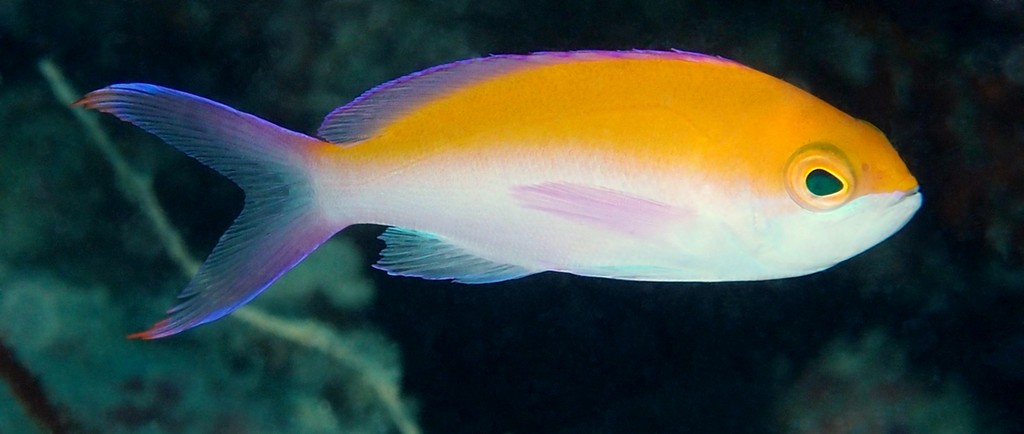NEMANTHIAS BICOLOR - (RANDALL, 1979)
Actinopterygii (Gigaclass) > Actinopteri (Class) > Teleostei (Subclass) > Perciformes (Order) > Percoidei (Suborder) > Anthiadidae (Family) > Nemanthias (Genus)
Anthias bicolore, Bicolor anthias, Fairy bass, Yellow-backed basslet, Yellowback basslet, Futairo-hanagoi, フタイロハナゴイ, 双色拟花鮨,
Synonymes
Anthias bicolor (Randall, 1979)
Mirolabrichthys bicolor (Randall, 1979)
Synonymes
Anthias bicolor (Randall, 1979)
Mirolabrichthys bicolor (Randall, 1979)
Pseudanthias bicolor (Randall, 1979)
-----------------------------
Description
-----------------------------
Description
Dorsal spines (total): 10; Dorsal soft rays (total): 16-18 (usually: 17); Anal spines: 3; Anal soft rays: 7-8 (rarely: 8); Pectoral fin rays: 19-21 (rarely: 21); Lateral line scales: 57-64; Gill rakers: 11-12 + 26-28; Depth of body: 2.74-3.04 in SL; Third dorsal spine prolonged in adult females, and second and third spines prolonged in adult males; Front of upper lip of males thickened and moderately pointed; No papillae along hind margin of orbit; Margins of subopercle and interopercle smooth in adults; Pelvic fins long, reaching at least to anus (generally to or beyond origin of anal fin); Teeth on vomer large; Patch of teeth on palatines broad (about 10 irregular rows of teeth at broadest place); No auxiliary scales on body; Mandible naked; Dorsal and anal fins naked. Max length: 13.0 cm TL. Depth range: 5 - 68 m.
Color
Males have a more intense coloration with a violet body and yellow running along the back through the upper caudal lobe. The females tend to be lavender in color with a yellow back and caudal fin. The dorsal fin of the male is edged in purple, and the first ray is elongated.
Etymology
Nemanthias: from Latin, nema = thread. Referring to first two dorsal-fin spines, which are filiform. + from Greek, anthias = a name of an unknow fish given by Aristotle in "History of Animals". This book, written in the fourth century BC, is one of the major texts on biology by the ancient Greek philosopher Aristotle (384–322 BC), who had studied at Plato's Academy in Athens.
bicolor: from Latin, bis = two + from old Latin, colos = color. Named bicolor in reference to the salmon pink of the upper half and lavender pink of the lower half of the body. When viewed underwater in its usual moderately deep habitat (hence with shades of red subdued), the back appears more yellow and the lower side more blue, thus enhancing the bicolored effect and making this species easily distinguished from other species.
Biology
Relatively uncommon inhabitant of lagoon patch reefs and outer reef slopes. Found in deep coastal to outer reef slopes, in current prone areas. Benthopelagic. It occurs in small groups above coral outcrops or near crevices or ledges. Bicolor Anthias are carnivorous and mainly feed upon zooplankton. Species of Pseudanthias are protogynous hermaphodites, meaning that they can change sex from female to male. They form small haremic groups with a dominant male and several females. Pelagic spawner with pelagic eggs and larvae.
Nemanthias: from Latin, nema = thread. Referring to first two dorsal-fin spines, which are filiform. + from Greek, anthias = a name of an unknow fish given by Aristotle in "History of Animals". This book, written in the fourth century BC, is one of the major texts on biology by the ancient Greek philosopher Aristotle (384–322 BC), who had studied at Plato's Academy in Athens.
bicolor: from Latin, bis = two + from old Latin, colos = color. Named bicolor in reference to the salmon pink of the upper half and lavender pink of the lower half of the body. When viewed underwater in its usual moderately deep habitat (hence with shades of red subdued), the back appears more yellow and the lower side more blue, thus enhancing the bicolored effect and making this species easily distinguished from other species.
Original description: Anthias (Mirolabrichthys) bicolor Randall, 1979 - Type locality: Waianae coast off Pokai Bay, Oahu Island, Hawaiian Islands, depth 33.5 meters.
Distribution
Distribution
Indo-West Pacific: Mascarenes and Maldives east to Hawaiian Islands, north to southern Japan, south to New Caledonia.
Biology
Relatively uncommon inhabitant of lagoon patch reefs and outer reef slopes. Found in deep coastal to outer reef slopes, in current prone areas. Benthopelagic. It occurs in small groups above coral outcrops or near crevices or ledges. Bicolor Anthias are carnivorous and mainly feed upon zooplankton. Species of Pseudanthias are protogynous hermaphodites, meaning that they can change sex from female to male. They form small haremic groups with a dominant male and several females. Pelagic spawner with pelagic eggs and larvae.
Similar species
Pseudanthias thompsoni (Fowler, 1923) - Reported from Western and central Pacific: Ogasawara Islands, Hawaiian Islands.
Last update: 2, September 2022
